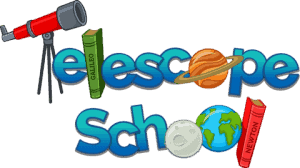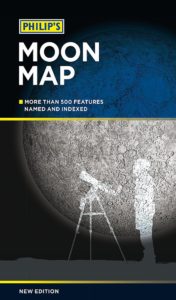A lot of you may have engaged in astronomy at some point in your life. Because of the stars, you may end up disregarding the moon as a sight to see. Since landing on the moon on July 20th, 1969, the moon has slowly taken a backstage to all things in the cosmos. But, if you think astronomy, well, it is the most significant and brightest object in the night sky. Making it easy to find and easy to view. You don’t need to be an expert to grab a pair of binoculars and start seeing the moon up close for the first time, it is breathtaking!
The Moon has a phase cycle, New Moon (no light reflecting), to a Full Moon (the full surface is reflecting). This cycle takes 14.76 days. Starting with the New Moon it takes 29.53 days to return to a New Moon. Observing the Moon with a telescope is best on days 1 to 12, and days 16 to 29.
What Can I See On the Moon?
Some of you may think that the moon is dull, but the moon has about 1,800 named features on its surface, including 1,500 craters. Another thing that makes for great lunar observations is observing its phases. Every month, or more specifically, every 29.53 days, the sun rises and sets over the same features of the moon. That means you would definitely need to apply sunscreen more than a couple times a day, well if the moon had beaches. To be safe, just wear a suit all day! Ironically, it only takes 27 days and 7 hours to rotate around the earth entirely. That is why the full moon always seems in a different spot.
The same side of the moon always faces the Earth. It is believed that the collision of a planetary embryo named “Theia” and earth early on (estimated 4.4 billion years ago) led to the moon and tied it to its slow rotation. So, that makes it good for us night sky viewers, because we always get the same features to map out and find. The explanation of the phases of the moon and the best viewing times will assist you in seeing just how overlooked the moon actually is.
What Is A New Moon
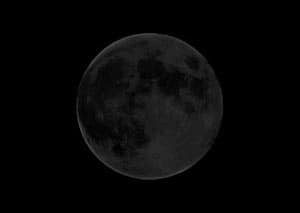 The start of the lunar phase cycle is what new moon means. At this phase, the moon is directly between the Earth and the sun. Because of this, 0% of the moon’s surface is illuminated at night. Hence, the “new moon” meaning.
The start of the lunar phase cycle is what new moon means. At this phase, the moon is directly between the Earth and the sun. Because of this, 0% of the moon’s surface is illuminated at night. Hence, the “new moon” meaning.
We cannot see a solar eclipse at this time either, however, because most of the time, the earth and the moon don’t sit exactly on the same plane. It even became a global competition to be the first to spot the New Moon.
Astrophotographer, Thierry Legault had recorded the razor-thin lunar crescent (the part of the moon that is illuminated by the sun which is visible from earth) precisely at the moment of New Moon on July 8, 2013.
The moon sets with the sun at this time, so if you try to join in with this exciting hunt, your telescope must already be set up late in the afternoon, just before the sun sets. However, you must be very careful at this time, because staring directly or near the sun with your telescope can cause severe damage to your eyes. Nobody has time for that!
Legault had achieved his sighting by using a special screen to avoid sunlight going directly at his telescope. He also used a near-infrared filter to reduce the sky’s brightness. However, even with all of this preparation, the crescent from the new moon is extremely faint, so finding it can be tricky. Setting up in the late afternoon will give some preparation time.
Waxing Crescent: And The Search For The Terminator
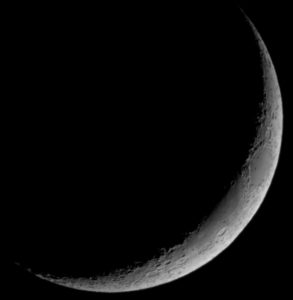
Waxing simply means growing. From the new moon, where the moon is not visible in the night sky, the waxing crescent is the phase where the crescent grows. The moon goes from being 0% illuminated during the new moon to having 50% of its surface illuminated (half moon) at the end of this phase.
This happens over the first week of the lunar cycle. In this phase, you can start observing the moon’s craters. You will get the maximum depth and detail if you look at objects on the lunar surface that are at or near what is called the terminator. The terminator is the line which separates night from day on the moon.
It will be very handy to have a lunar map at this point to locate and identify the moon’s craters. More about moon maps are near the end.
First Quarter: More Like Half Time
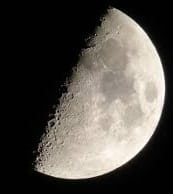
During this phase, the moon already has its whole right-hand side illuminated at night. The first quarter is the best time to look into the moon and see the details because it is the time when the terminator is at its longest.
Another way of saying that the sun creates shadows because it is at an angle to the moons face. The shadows give depth to your viewing. Almost like watching 2D movies, then watching a 3D movie (without needing cardboard glasses). It is just more to see.
Also at this time, some maria (large dark, basaltic plains) on the moon are now visible. During this phase, the moon rises around midday and sets around midnight. This is my favorite time because it is easy to find and you can still go to bed at a decent hour.
Waxing Gibbous: What To Find On The Way To Full Moon
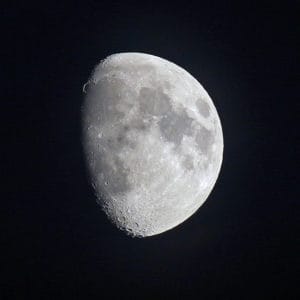 This is the phase where the illuminated part of the moon continues to grow from being 50% illuminated to just before full moon (100% illuminated). One of the most famous things to find during this phase is the Tycho. Tycho is one of the moons brightest craters, which is named after Danish astronomer Tycho Brahe.
This is the phase where the illuminated part of the moon continues to grow from being 50% illuminated to just before full moon (100% illuminated). One of the most famous things to find during this phase is the Tycho. Tycho is one of the moons brightest craters, which is named after Danish astronomer Tycho Brahe.
It is estimated to be 108 million years old. The moon rises in the afternoon, before sunset and sets in the morning, before sunrise in this phase making it my second favorite time to view.
Full Moon: Why Can’t I see Craters?
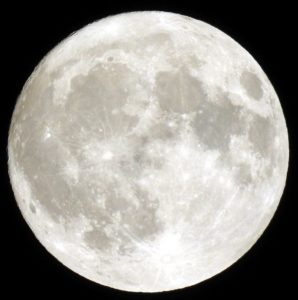
The full moon happens when the moon is halfway through its lunar cycle. The moon is located behind the earth now, and just from its name alone, the moon is now fully illuminated. So, you ask why is the moon fully lit by the sun if the earth is in the way. Lunar eclipses don’t happen every time, because the Earth and the moon are not in the exact same orbital plane.
The Full Moon is the time when the moon is so bright that you will be able to see the lunar rays. These can be found surrounding some craters on the moon and comprises of radial streaks of material blasted from the ground during impact from a meteor. (Or crashed space ship?)
You may think that because the moon is fully illuminated that it would be the best time to observe the moon. Actually, this is the worst time to view the moon because the moon becomes super bright at this phase and there are no shadows to create depth and contrast.
This makes it hard to see features on the moon. Also, because the moon is at its brightest, it also makes it harder to see other celestial bodies in the night sky. Kind of like when you’re trying to drive a car and see the road while the interior light is on. It is just easier to see bright objects from a dark space.
Waning Gibbous: Wax On, Wax Off
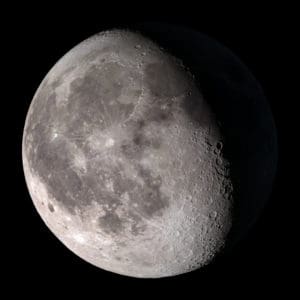
This phase is similar to waxing gibbous, only this time, the dark and illuminated parts are reversed. The crescent is now shrinking instead of growing while the terminator moves toward the same location marking a half moon. The light coming from a different direction across the features of the moon can give new contrast and viewing pleasure.
I think of it as having a flashlight looking for lost keys in the dark. You move the flashlight around to create contrast and depth from different directions to try and find you’re lost keys. This can be another good time to look at Tycho and see different features.
Last Quarter: Can You Spare a Dime?
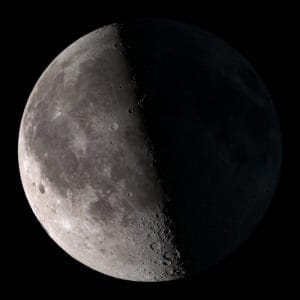
Again, this phase is similar to the first quarter, but the dark and illuminated parts are reversed. Because of this, it will now be the perfect time to observe the left side of the moon. You will be able to see craters that are not visible during the first quarter.
This is when the moon goes from half moon through the waning gibbous on down to no, or new moon again. Basically, the moon is down and out heading to zero, but no fears, it will be bounce back again.
Waning Crescent: On the way to Zero
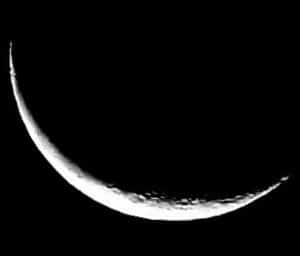
This marks the last week of the lunar cycle. The crescent continuous to shrink and eventually, it becomes too thin and moves too close to the sun for you to see it. A common challenge during this phase of the moon is to find the craters named Mee and Hainz.
This is where a good moon map can come in handy. Also, as the moon disappears, or rather, just not visible in the sky, makes this is a great time to try and view some other celestial objects. We talk more about what to see near the end of the article.
Moon Maps Do I Need One?
To really take your moon viewing experience to the next level, you should use moon maps. The use of these allows you to plan your moon viewing ahead of time, like on a rainy day.
By determining which moon features you want to see you can save a ton of time. The joy of astronomy is not only observing the heavenly bodies on your telescope but also in knowing and identifying them. Here a few good moon maps; including the one I use.
• Sky and Telescope’s Moon Map
– this is the best moon map for beginners because less expensive. It features a detailed atlas of the moon. It also comes with a complete index of the features on the moon map which makes moon viewing a lot easier.
It folds out to a total size of 11×17 inches. It is also laminated making it protected from moisture and dew that can form at night. Making it an excellent viable map solution if you are starting out. Check out there downloadable version here.
• Sky and Telescope’s Field Map of the Moon
– this is more expensive than the Sky & Telescope’s Moon Map, but it also features a lot more details. It is probably the most elaborate map of the moon with over 1,000 labeled landmarks.
It folds out to a size of 12×12 inches, and it is also laminated to protect it from moisture and dew. Check Amazon to see if it is available
• Philip’s Moon Map
– if you really want to get the best and most detailed moon map available, then this is for you. It is more expensive than the previous two, but it has the most detailed insight. Some features even have their own close-up pictures for you to easily identify the feature you are viewing.
There are also images of the moon every day throughout its lunar cycle. This is useful as you will be able to see where the terminator will lie at any given day, and you will be able to plan your moon viewing with greater detail.
I like this book with its map because it even points out where the spacecraft have landed (only earth based vessels). It’s awesome, with incredible detail. This is what I recommend if you can find it at a reasonable price. I have noticed wide-ranging prices. I actually got mine from eBay. Amazon may have new from time to time though. Check and see here.
Moon Map: Which One Do You Need
Using moon maps, you must remember that some maps show you an image of the moon which is right side up like the Philip’s Moon Map, while others show it to you upside down like Sky & Telescope’s Field Map of the Moon.
Much depends on your telescope to what you actually will see; that is it will be imaged to your eye right side up, or upside down. So, before you purchase a map test to see if your scope images upside down or not. Then, buy a map that makes it easy to revert to while viewing the moon.
Best Things To View Prior And After a New Moon
After, the moon, you may find it also interesting to observe the planets. The easiest planets to find in the sky and observe are Jupiter, Saturn, and Mars. We say these 3 planets because you will be able to see notable surface details and weather phenomena. With Jupiter, you will also be able to observe 4 of its moons by the shadows that they cast on the surface of Jupiter.
Saturn also has some visible moons, but come on, who doesn’t want to see the rings. Mars is a little harder to see and find. It has an orbit that brings it close to earth every 2 years. The really close cycle is 17 years or so. We will let NASA worry about really close periods. Looking at Venus and Mercury are hard because they are closer to the sun, and toward the sun. Making light the main problem. Too much light like when the full moon hides features.
The other planets Neptune and Uranus are very far away that they will only appear as bluish or greenish disks. Pluto, not a planet in our solar system anymore, but it can also be seen from a telescope, although it will be challenging to do so.
Once you see it, it will just look like a small and faint star. It would probably make sense to look for bigger farther things, like galaxies and nebula. Here are some things easier to find than Pluto: Andromeda M31 galaxy, Orion Nebula M42, and Albireo a Beautiful Double Star. Plus there are tons more.
Something that is close and you can use binoculars, or a telescope is earth orbiting satellites. The largest of which is the International Space Station. Since it is incredibly close compared to other astronomic things, you will be amazed at how detailed it will look through your telescope.
The space station will move fast through the sky and having your telescope ready to go will improve your chances to view it. You will have to move your slow motion controls really fast.
Need More?
Would you like to hear more about “ Why Planets Appear Black and White” or “Binoculars, 10 best things to view” ,or “How Much Telescopes Weigh” I believe in, and use, or have used. Please feel free to click on to another article, or the resource page to learn more.
